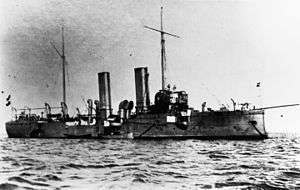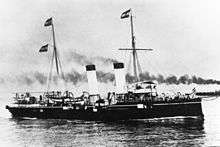SMS Leopard
 Leopard, date unknown | |
| History | |
|---|---|
| Name: | Leopard |
| Laid down: | January 1885 |
| Launched: | 10 September 1885 |
| Completed: | 31 March 1886 |
| Fate: | Broken up, 1920 |
| General characteristics | |
| Class and type: | Panther-class cruiser |
| Displacement: | 1,557 t (1,532 long tons; 1,716 short tons) |
| Length: | 73.19 m (240 ft 1 in) |
| Beam: | 10.39 m (34 ft 1 in) |
| Draft: | 4.28 m (14 ft 1 in) |
| Installed power: | 6,380 indicated horsepower (4,760 kW) |
| Propulsion: | 2 × compound steam engines |
| Speed: | 18.7 knots (34.6 km/h; 21.5 mph) |
| Crew: | 186 |
| Armament: |
|
| Armor: | Deck: 12 mm (0.47 in) |
SMS Leopard was a torpedo cruiser (Torpedoschiff) of the Austro-Hungarian Navy. She and her sister ship, SMS Panther, were part of a program to build up Austria-Hungary's fleet of torpedo craft in the 1880s. Both ships, the only members of the Panther class, were built in Britain at the Armstrong shipyard in Elswick. Leopard was laid down in January 1885, launched in September 1885, and completed in March 1886. She was armed with a battery of two 12 cm (4.7 in) guns and ten 47 mm (1.9 in) guns, along with four 356 mm (14.0 in) torpedo tubes.
Leopard spent much of her career in the main Austro-Hungarian fleet. During this period, she visited Spain for the 1888 Barcelona Universal Exposition, and took part in an international naval demonstration off Crete in 1897 in an attempt to limit the Greco-Turkish War. From 1900, Leopard made two major overseas deployments, including a tour of the Pacific Ocean in 1900–1901, and a stint in the East Asia squadron in 1907–1909. Upon returning to Austria-Hungary, the ship was modernized in 1910 and then decommissioned in May 1914, shortly before the start of World War I in July. The ship was immediately reactivated and stationed in Pola as a guard ship, where she remained for the duration of the conflict. After Austria-Hungary's defeat, Leopard was ceded to Britain as a war prize and sold to ship breakers in Italy in 1920.
Design
Leopard was 73.19 meters (240 ft 1 in) long overall, with a beam of 10.39 m (34 ft 1 in) and a draft of 4.28 m (14 ft 1 in). She displaced 1,557 t (1,532 long tons; 1,716 short tons). The ship's propulsion system consisted of a pair of two-cylinder vertical compound steam engines. On trials, Leopard reached a speed of 18.7 knots (34.6 km/h; 21.5 mph) from 6,380 indicated horsepower (4,760 kW). Her crew numbered 186 officers and men.[1]
The ship was armed with two 12-centimeter (4.7 in) 35-caliber (cal.) guns manufactured by Krupp in single mounts. These were supported by a battery of four 47 mm (1.9 in) quick-firing guns and six 47 mm revolver cannon. She was also armed with four 14 in (360 mm) torpedo tubes. The torpedo tubes were located singly, in the bow, stern, and at either beam. Leopard was protected with a thin 12 mm (0.47 in) armored deck.[1]
Service

The keel for Leopard was laid down in January 1885 at the Armstrong shipyard in Elswick in Britain. Her completed hull was launched on 10 September that year, and fitting-out work was completed on 31 March 1886.[1] She participated in the annual fleet maneuvers in 1888, along with the ironclads Don Juan d'Austria, Kaiser Max, Custoza, Tegetthoff, and the cruisers Panther and Meteor.[2] That year, Leopard and Panther joined a squadron that included the ironclads Tegetthoff, Custoza, Kaiser Max, Don Juan d'Austria, and Prinz Eugen to represent Austria-Hungary in the opening ceremonies for the Barcelona Universal Exposition. This was the largest squadron of the Austro-Hungarian Navy that had operated outside the Adriatic.[3] While on the way back home, Leopard, Custoza, Kaiser Max, and Prinz Eugen stopped in Malta.[4]
In 1897, the Austro-Hungarian Navy sent a squadron that included Leopard to join an international naval demonstration off Crete in 1897 during a period of tension between Greece and the Ottoman Empire that culminated in the Greco-Turkish War. The Austro-Hungarian contingent, which also included the ironclad Kronprinzessin Erzherzogin Stephanie, the armored cruiser Kaiserin und Königin Maria Theresia, and the torpedo cruisers Tiger and Sebenico, three destroyers, and eight torpedo boats, was the third largest squadron to take part in the demonstration, after the British and Italian fleets. Austria-Hungary, displeased with the settlement that left Crete with a Greek ruler but nominally under Turkish control, withdrew its ships in March 1898, before the other members of the international fleet.[5]
In 1900–1901, Leopard embarked on a tour of the Pacific Ocean, which included a visit to Australia. During this period, she was temporarily assigned to the East Asia squadron, under the command of then-Captain Anton Haus, who went on to command the Austro-Hungarian fleet during World War I.[6] She made another deployment to East Asian waters in 1907–1909; she was relieved by her sister Panther.[7] Leopard was rearmed in 1910, losing most of her gun battery and being equipped with four 66 mm (2.6 in) 45-cal. guns and ten 47 mm QF guns. The ship was decommissioned on 15 May 1914, just a month and a half before the outbreak of World War I. She was assigned as a harbor guard ship in Pola, where she remained for the duration of the war. Under the terms of the Treaty of Saint-Germain-en-Laye, Britain received Leopard as a war prize in 1920, but she was instead sold to ship breakers in Italy and scrapped.[8]
Notes
References
- Brassey, Thomas A., ed. (1889). "Foreign Naval Manoevres". The Naval Annual. Portsmouth: J. Griffin & Co.: 450–455. OCLC 5973345.
- Gardiner, Robert, ed. (1979). Conway's All the World's Fighting Ships: 1860–1905. London: Conway Maritime Press. ISBN 0-85177-133-5.
- Greger, René (1976). Austro-Hungarian Warships of World War I. London: Ian Allan. ISBN 978-0-7110-0623-2.
- Sondhaus, Lawrence (1994). The Naval Policy of Austria-Hungary, 1867–1918. West Lafayette: Purdue University Press. ISBN 978-1-55753-034-9.